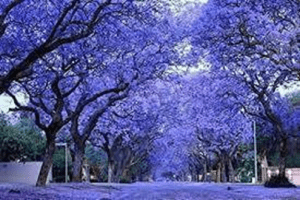TAG: GS 3: ECOLOGY AND ENVIRONMENT
THE CONTEXT: The vibrant streets of Mexico City, known for their annual transformation into a purple spectacle, are witnessing an unprecedented event this year. The iconic jacaranda trees, celebrated for their beauty and ecological significance, have started blooming far earlier than usual, triggering both curiosity and concern among residents and scientists.
EXPLANATION:
- Traditionally, the jacaranda trees in Mexico City begin to bloom towards the end of March, signaling the arrival of spring.
- However, this year, a notable number of jacarandas have started flowering as early as January, a period when they are expected to remain dormant during the winter months.
- This unexpected phenomenon has raised alarm bells, prompting scientists to explore the root causes.
- Local scientists from the Institute of Atmospheric Sciences and Climate Change Research at the National Autonomous University of Mexico (UNAM), are leading investigations into the extent of this early-bloom phenomenon.
- The need for a comprehensive analysis by comparing blooming patterns year to year has been emphasized.
- He attributes the early blossoms to climate change, pointing out that rising temperatures caused winter in Mexico City to conclude prematurely in mid-January, contrary to the usual late March.
- Utilizing satellite imagery and on-the-ground observations, the aim was to establish a correlation between the rising temperatures and the premature blooming of jacarandas.
- This approach reflects a proactive stance towards understanding and mitigating the impacts of climate change.
Historical Roots: Jacarandas as a Cultural and Environmental Staple
- The jacaranda’s presence in Mexico City has deep historical roots.
- Initially inspired by the Japanese cherry trees, President opted for jacarandas due to their adaptability to the city’s temperate climate.
- Introduced by Japanese landscape architect Tatsugoro Matsumoto in the late 19th century, jacarandas have since become an integral part of the city’s landscape, providing aesthetic beauty and ecological benefits.

- Jacaranda mimosifolia is a sub-tropical tree native to south-central South America that has been widely planted elsewhere because of its attractive and long-lasting violet-colored flowers.
- It is also known as the jacaranda, blue jacaranda, black poui, Nupur or fern tree.
- The tree grows to a height of up to 20 m (66 ft).Its bark is thin and grey-brown, smooth when the tree is young but eventually becoming finely scaly.
- While not native to Mexico, jacarandas play a crucial role in the city’s ecosystem.
- They attract a diverse range of pollinators, including hummingbirds and bees, more than many native trees.
- Any alteration in the flowering pattern could have cascading effects on these populations, emphasizing the interconnectedness of nature and the potential consequences of climate change on urban biodiversity.
Conclusion: A City in Bloom and in Flux
- As Mexico City witnesses the premature blossoming of its beloved jacaranda trees, the spectacle that once symbolized the arrival of spring now serves as a stark reminder of the ecological changes brought about by climate change. The collaborative efforts of scientists, coupled with public awareness, provide a foundation for understanding and addressing the challenges posed by this early-bloom phenomenon, emphasizing the need for sustainable practices to preserve the cultural and environmental significance of the iconic jacarandas.

